Jiaxing Zhang
AC-Refiner: Efficient Arithmetic Circuit Optimization Using Conditional Diffusion Models
Jul 03, 2025Abstract:Arithmetic circuits, such as adders and multipliers, are fundamental components of digital systems, directly impacting the performance, power efficiency, and area footprint. However, optimizing these circuits remains challenging due to the vast design space and complex physical constraints. While recent deep learning-based approaches have shown promise, they struggle to consistently explore high-potential design variants, limiting their optimization efficiency. To address this challenge, we propose AC-Refiner, a novel arithmetic circuit optimization framework leveraging conditional diffusion models. Our key insight is to reframe arithmetic circuit synthesis as a conditional image generation task. By carefully conditioning the denoising diffusion process on target quality-of-results (QoRs), AC-Refiner consistently produces high-quality circuit designs. Furthermore, the explored designs are used to fine-tune the diffusion model, which focuses the exploration near the Pareto frontier. Experimental results demonstrate that AC-Refiner generates designs with superior Pareto optimality, outperforming state-of-the-art baselines. The performance gain is further validated by integrating AC-Refiner into practical applications.
UniTTS: An end-to-end TTS system without decoupling of acoustic and semantic information
May 23, 2025Abstract:The emergence of multi-codebook neutral audio codecs such as Residual Vector Quantization (RVQ) and Group Vector Quantization (GVQ) has significantly advanced Large-Language-Model (LLM) based Text-to-Speech (TTS) systems. These codecs are crucial in separating semantic and acoustic information while efficiently harnessing semantic priors. However, since semantic and acoustic information cannot be fully aligned, a significant drawback of these methods when applied to LLM-based TTS is that large language models may have limited access to comprehensive audio information. To address this limitation, we propose DistilCodec and UniTTS, which collectively offer the following advantages: 1) This method can distill a multi-codebook audio codec into a single-codebook audio codec with 32,768 codes while achieving a near 100\% utilization. 2) As DistilCodec does not employ a semantic alignment scheme, a large amount of high-quality unlabeled audio (such as audiobooks with sound effects, songs, etc.) can be incorporated during training, further expanding data diversity and broadening its applicability. 3) Leveraging the comprehensive audio information modeling of DistilCodec, we integrated three key tasks into UniTTS's pre-training framework: audio modality autoregression, text modality autoregression, and speech-text cross-modal autoregression. This allows UniTTS to accept interleaved text and speech/audio prompts while substantially preserving LLM's text capabilities. 4) UniTTS employs a three-stage training process: Pre-Training, Supervised Fine-Tuning (SFT), and Alignment. Source code and model checkpoints are publicly available at https://github.com/IDEA-Emdoor-Lab/UniTTS and https://github.com/IDEA-Emdoor-Lab/DistilCodec.
GE-Chat: A Graph Enhanced RAG Framework for Evidential Response Generation of LLMs
May 15, 2025Abstract:Large Language Models are now key assistants in human decision-making processes. However, a common note always seems to follow: "LLMs can make mistakes. Be careful with important info." This points to the reality that not all outputs from LLMs are dependable, and users must evaluate them manually. The challenge deepens as hallucinated responses, often presented with seemingly plausible explanations, create complications and raise trust issues among users. To tackle such issue, this paper proposes GE-Chat, a knowledge Graph enhanced retrieval-augmented generation framework to provide Evidence-based response generation. Specifically, when the user uploads a material document, a knowledge graph will be created, which helps construct a retrieval-augmented agent, enhancing the agent's responses with additional knowledge beyond its training corpus. Then we leverage Chain-of-Thought (CoT) logic generation, n-hop sub-graph searching, and entailment-based sentence generation to realize accurate evidence retrieval. We demonstrate that our method improves the existing models' performance in terms of identifying the exact evidence in a free-form context, providing a reliable way to examine the resources of LLM's conclusion and help with the judgment of the trustworthiness.
RISE: Radius of Influence based Subgraph Extraction for 3D Molecular Graph Explanation
May 04, 2025Abstract:3D Geometric Graph Neural Networks (GNNs) have emerged as transformative tools for modeling molecular data. Despite their predictive power, these models often suffer from limited interpretability, raising concerns for scientific applications that require reliable and transparent insights. While existing methods have primarily focused on explaining molecular substructures in 2D GNNs, the transition to 3D GNNs introduces unique challenges, such as handling the implicit dense edge structures created by a cut-off radius. To tackle this, we introduce a novel explanation method specifically designed for 3D GNNs, which localizes the explanation to the immediate neighborhood of each node within the 3D space. Each node is assigned an radius of influence, defining the localized region within which message passing captures spatial and structural interactions crucial for the model's predictions. This method leverages the spatial and geometric characteristics inherent in 3D graphs. By constraining the subgraph to a localized radius of influence, the approach not only enhances interpretability but also aligns with the physical and structural dependencies typical of 3D graph applications, such as molecular learning.
A Semantic Communication System for Real-time 3D Reconstruction Tasks
Dec 02, 2024



Abstract:3D semantic maps have played an increasingly important role in high-precision robot localization and scene understanding. However, real-time construction of semantic maps requires mobile edge devices with extremely high computing power, which are expensive and limit the widespread application of semantic mapping. In order to address this limitation, inspired by cloud-edge collaborative computing and the high transmission efficiency of semantic communication, this paper proposes a method to achieve real-time semantic mapping tasks with limited-resource mobile devices. Specifically, we design an encoding-decoding semantic communication framework for real-time semantic mapping tasks under limited-resource situations. In addition, considering the impact of different channel conditions on communication, this paper designs a module based on the attention mechanism to achieve stable data transmission under various channel conditions. In terms of simulation experiments, based on the TUM dataset, it was verified that the system has an error of less than 0.1% compared to the groundtruth in mapping and localization accuracy and is superior to some novel semantic communication algorithms in real-time performance and channel adaptation. Besides, we implement a prototype system to verify the effectiveness of the proposed framework and designed module in real indoor scenarios. The results show that our system can complete real-time semantic mapping tasks for common indoor objects (chairs, computers, people, etc.) with a limited-resource device, and the mapping update time is less than 1 second.
CAPE: A Chinese Dataset for Appraisal-based Emotional Generation using Large Language Models
Oct 18, 2024



Abstract:Generating emotionally appropriate responses in conversations with large language models presents a significant challenge due to the complexities of human emotions and cognitive processes, which remain largely underexplored in their critical role in social interactions. In this study, we introduce a two-stage automatic data generation framework to create CAPE, a Chinese dataset named Cognitive Appraisal theory-based Emotional corpus. This corpus facilitates the generation of dialogues with contextually appropriate emotional responses by accounting for diverse personal and situational factors. We propose two tasks utilizing this dataset: emotion prediction and next utterance prediction. Both automated and human evaluations demonstrate that agents trained on our dataset can deliver responses that are more aligned with human emotional expressions. Our study shows the potential for advancing emotional expression in conversational agents, paving the way for more nuanced and meaningful human-computer interactions.
Fostering Natural Conversation in Large Language Models with NICO: a Natural Interactive COnversation dataset
Aug 18, 2024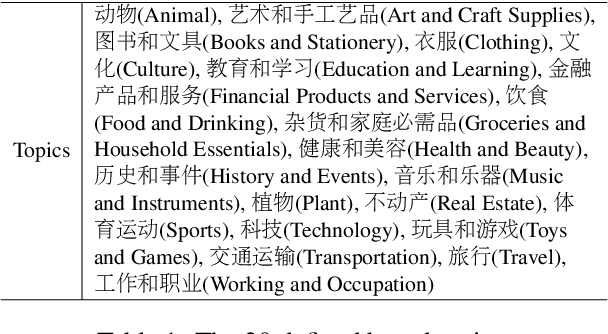
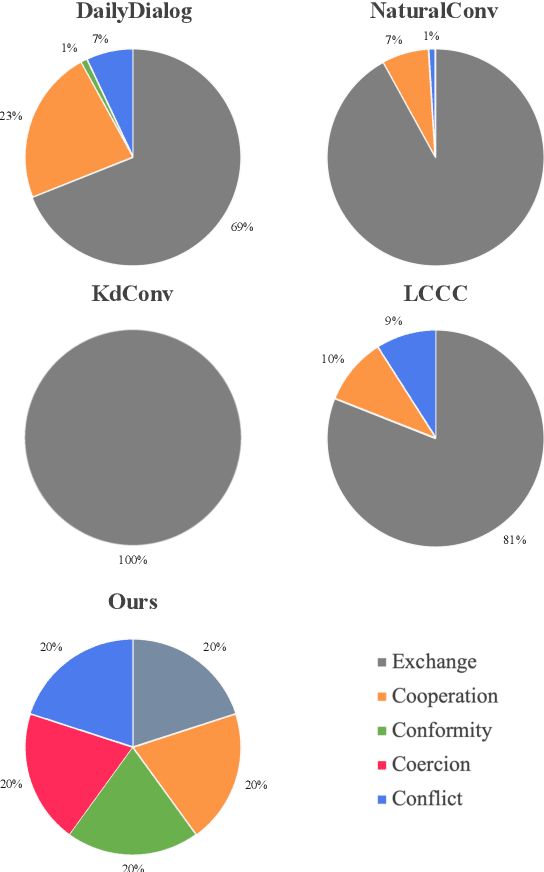
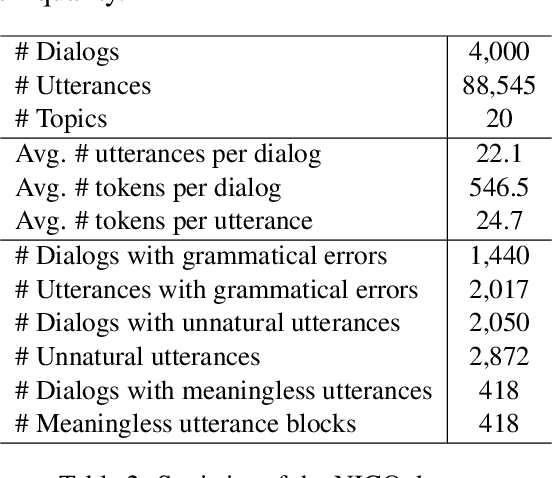
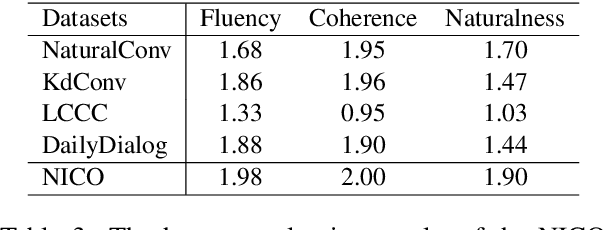
Abstract:Benefiting from diverse instruction datasets, contemporary Large Language Models (LLMs) perform effectively as AI assistants in collaborating with humans. However, LLMs still struggle to generate natural and colloquial responses in real-world applications such as chatbots and psychological counseling that require more human-like interactions. To address these limitations, we introduce NICO, a Natural Interactive COnversation dataset in Chinese. We first use GPT-4-turbo to generate dialogue drafts and make them cover 20 daily-life topics and 5 types of social interactions. Then, we hire workers to revise these dialogues to ensure that they are free of grammatical errors and unnatural utterances. We define two dialogue-level natural conversation tasks and two sentence-level tasks for identifying and rewriting unnatural sentences. Multiple open-source and closed-source LLMs are tested and analyzed in detail. The experimental results highlight the challenge of the tasks and demonstrate how NICO can help foster the natural dialogue capabilities of LLMs. The dataset will be released.
LLMExplainer: Large Language Model based Bayesian Inference for Graph Explanation Generation
Jul 23, 2024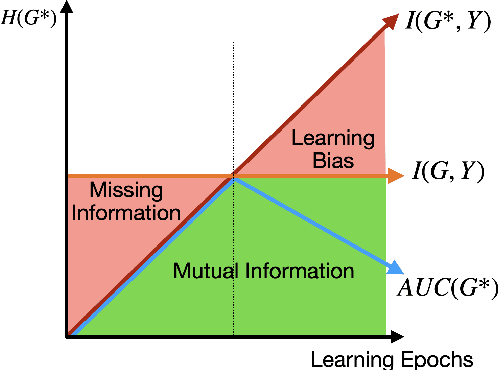

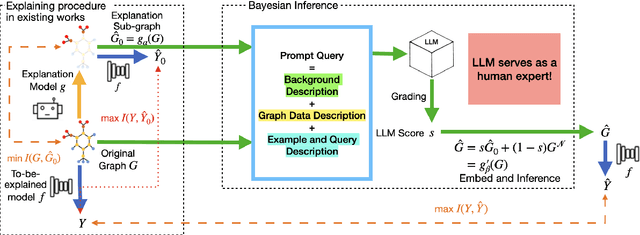

Abstract:Recent studies seek to provide Graph Neural Network (GNN) interpretability via multiple unsupervised learning models. Due to the scarcity of datasets, current methods easily suffer from learning bias. To solve this problem, we embed a Large Language Model (LLM) as knowledge into the GNN explanation network to avoid the learning bias problem. We inject LLM as a Bayesian Inference (BI) module to mitigate learning bias. The efficacy of the BI module has been proven both theoretically and experimentally. We conduct experiments on both synthetic and real-world datasets. The innovation of our work lies in two parts: 1. We provide a novel view of the possibility of an LLM functioning as a Bayesian inference to improve the performance of existing algorithms; 2. We are the first to discuss the learning bias issues in the GNN explanation problem.
Interpreting Graph Neural Networks with In-Distributed Proxies
Feb 03, 2024

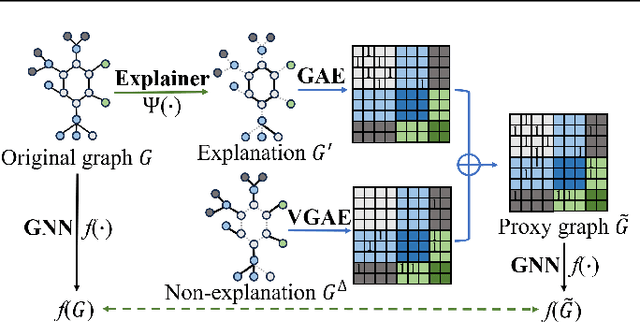
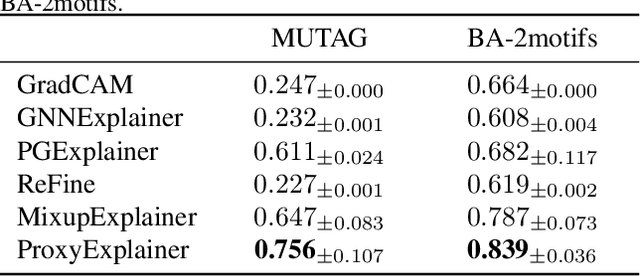
Abstract:Graph Neural Networks (GNNs) have become a building block in graph data processing, with wide applications in critical domains. The growing needs to deploy GNNs in high-stakes applications necessitate explainability for users in the decision-making processes. A popular paradigm for the explainability of GNNs is to identify explainable subgraphs by comparing their labels with the ones of original graphs. This task is challenging due to the substantial distributional shift from the original graphs in the training set to the set of explainable subgraphs, which prevents accurate prediction of labels with the subgraphs. To address it, in this paper, we propose a novel method that generates proxy graphs for explainable subgraphs that are in the distribution of training data. We introduce a parametric method that employs graph generators to produce proxy graphs. A new training objective based on information theory is designed to ensure that proxy graphs not only adhere to the distribution of training data but also preserve essential explanatory factors. Such generated proxy graphs can be reliably used for approximating the predictions of the true labels of explainable subgraphs. Empirical evaluations across various datasets demonstrate our method achieves more accurate explanations for GNNs.
Learning to Trust Your Feelings: Leveraging Self-awareness in LLMs for Hallucination Mitigation
Jan 27, 2024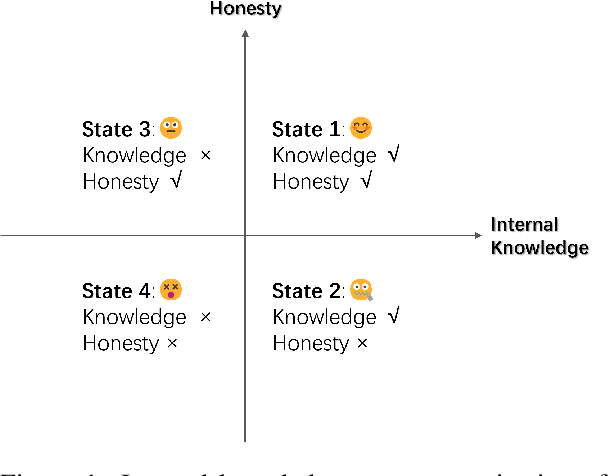
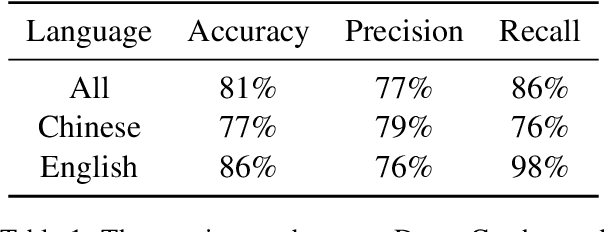

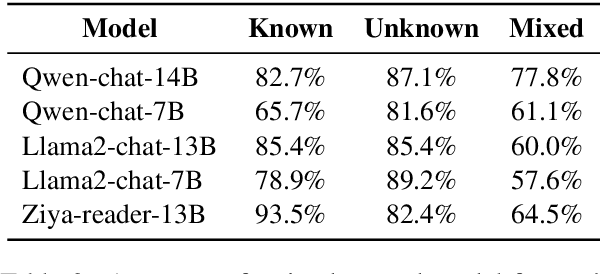
Abstract:We evaluate the ability of Large Language Models (LLMs) to discern and express their internal knowledge state, a key factor in countering factual hallucination and ensuring reliable application of LLMs. We observe a robust self-awareness of internal knowledge state in LLMs, evidenced by over 85% accuracy in knowledge probing. However, LLMs often fail to express their internal knowledge during generation, leading to factual hallucinations. We develop an automated hallucination annotation tool, Dreamcatcher, which merges knowledge probing and consistency checking methods to rank factual preference data. Using knowledge preference as reward, We propose a Reinforcement Learning from Knowledge Feedback (RLKF) training framework, leveraging reinforcement learning to enhance the factuality and honesty of LLMs. Our experiments across multiple models show that RLKF training effectively enhances the ability of models to utilize their internal knowledge state, boosting performance in a variety of knowledge-based and honesty-related tasks.
 Add to Chrome
Add to Chrome Add to Firefox
Add to Firefox Add to Edge
Add to Edge